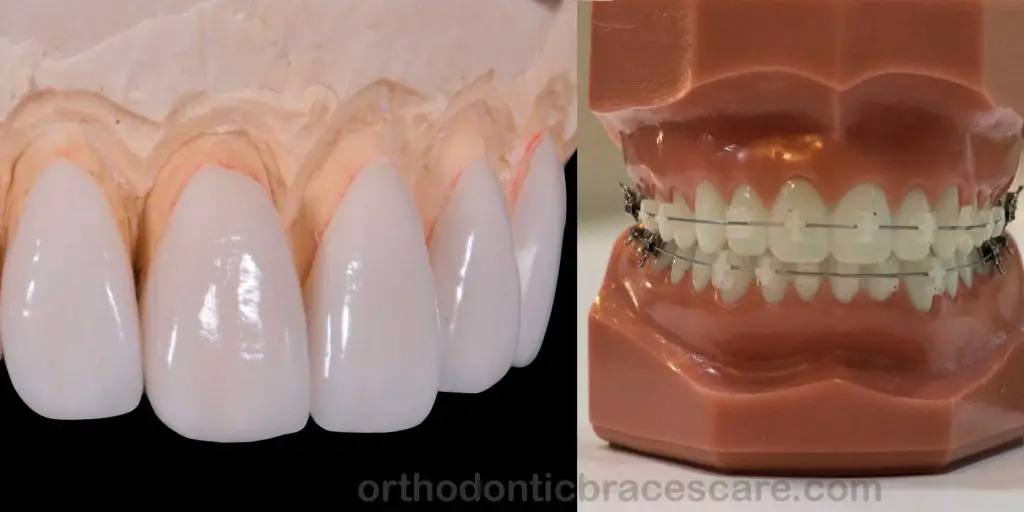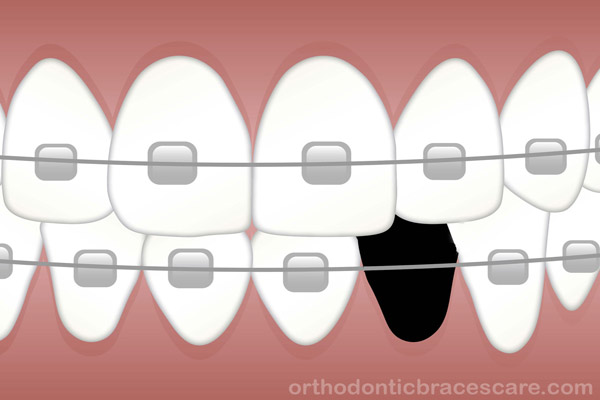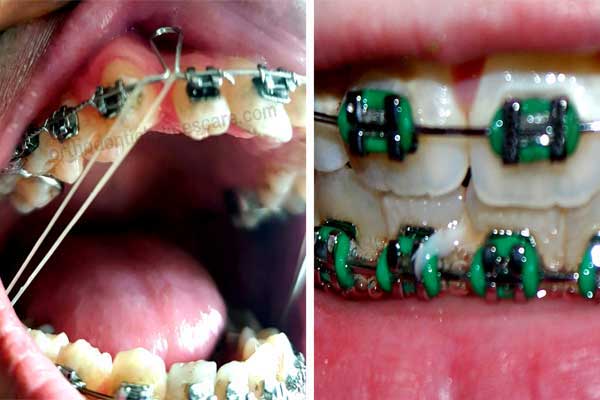It’s very common when you get older you may have one or two teeth with dental restorations or prostheses. On the other hand, adult braces or Invisalign are getting more popular day by day. Now if you need braces you may get worried about whether can adults get braces or Invisalign with crowns, bridges, and veneers?
Adults can get braces or Invisalign with crowns, bridges, and veneers on their teeth for orthodontic treatment purposes such as teeth straightening or gaps closing. However, it needs some special attention. The planning and duration of treatment may differ from those who have natural teeth, especially for bridges and veneers.
You might have other concerns like can this damage your prostheses or, can you get a good outcome from treatment with braces or Invisalign in this case? Another question is whether we can use metal, lingual or ceramic braces or not. In this article, we’ll discuss all of these.
Can adults wear metal, ceramic, or, lingual braces with crowns, bridges, and veneers?
Although every case is different, it is possible for an adult to wear metal, ceramic, or lingual braces with the crown. Planning for treatment is almost identical to that for individuals with natural teeth. However, there might be a few special circumstances, especially with bridges and porcelain veneers.
As there are many options, you don’t need to worry if you want braces with a front tooth crown, post crowns, or bridges.

Braces with crown
A crown is placed on a tooth when it’s damaged due to decay, trauma, and other causes. A crown restores the proper function of teeth as well as enhances esthetic.
Sometimes, you may need a root canal treatment (RCT) before the crown is installed. Sometimes, there is no need for RCT. Your orthodontist also considers where RCT was performed in your teeth or not.
During RCT dentists drill out your enamel and dentin and remove the infected pulp and make it sterile. Then, he or she fills it with a strong subsentence. After that crown is placed over it. So, can you wear braces with crowns and RCT?
Your orthodontist must be sure whether your teeth are strong enough to bear the pressure given by braces or not. If no RCT was performed then it may not be a concern. But, in these cases, treatment planning is the same as natural teeth.
However, It’s easy for an orthodontist to put braces on natural teeth. When he or she has to place braces to a dental prosthesis, it may take special techniques.
In natural teeth, your orthodontist will use different types of adhesive, while in these protheses he or she will use other types of adhesive. Braces make better bonding with natural teeth. Because of that brackets may fall off from a crown.
Another difference is it may take more time to complete orthodontic treatment. The reason for that is teeth may have to move slower. Your orthodontist will observe the treatment progress and condition of teeth so that nothing goes wrong.
Sometimes you may have a tooth with a temporary crown. In this condition, first, you should replace it with a permanent dental crown from your dentist, then take treatment with braces.
There are some other queries such as-
Can you get a crown while wearing braces or should you get a crown done before or after the braces?
As it’s best to perform orthodontic treatment in natural teeth, you should get your orthodontic treatment completed first.
Even if you need a crown before or during orthodontic treatment, you should wait till the braces are taken off. During this time, you may get a temporary crown from your dentist. But, you must consult with your orthodontist.
Braces with bridge
There is a problem regarding bridges. It may not be possible to move bridges, as there is more than one tooth that is attached. So, can an adult get braces with a bridge?
When an orthodontist applies force to move them to the desired place, they can be damaged. But, he or she needs to move the teeth under bridges, he or she could cut the bridges into sections. That means you have to take a new bridge after completion of orthodontic treatment.
You may still wear any brace with bridges. In this case, your orthodontist applies force to your natural teeth only. But, you have to consider the outcome of treatment, because it may not be as satisfactory as a treatment in natural teeth.
However, Invisalign or removable teeth aligners can be a great option with teeth with bridges if your problem isn’t so severe (discussed later).
Should you get a bridge done before or after the braces?
Because of the facts I have explained, you should get the braces to align your teeth properly first if you have a choice. By doing so you can get a good result, as there is no obstacle to move shift a tooth into a new position.
Before starting the treatment procedure, your orthodontist may tell your dentist to make a temporary crown or pontic in the teeth that need restoration. After your braces are removed, you may get a bridge on those teeth.
But, if you have no other problem, replace the tooth with a dental implant which is much better than a bridge.
Braces with veneers
Though it’s not impossible to get braces with veneer, you may not get a good outcome. Veneers are usually made up of porcelain. It’s very difficult to attach braces or brackets to porcelain veneers.
Even if we bond them together, it can’t last very long. The bracket may damage the smoothness of veneers and damage them as well.
Also, your orthodontist has to check how much tooth structure was removed to place veneers.
But, still, we can move teeth to our desirable place. Invisalign can be a better option for teeth with veneers (discussed later).
Braces that should be considered
If you need braces for orthodontic treatment with dental restorations and you don’t know about types of braces, let’s take a look at those.
Metal or traditional braces are commonly used in orthodontics. It’s available in various colors ranging from metallic to any color that a child may like.
Ceramic braces are tooth-colored and transparent. It’s aesthetically pleasing. But, there are also metal wires.
On the other hand, lingual braces are metallic in color and placed behind teeth. So, someone can’t notice it from outside. But, they can’t be comfortable to wear.
Both metal and ceramic braces perform well to move teeth and easy to adjust. Also, one of those may be a good option when they are used with dental restorations. Ceramic and lingual braces are more expensive.
These fixed braces are so difficult to attach to a tooth with a dental restoration. So, you may need to consider two options. One is you may require other procedures to attach these braces to crowns like using orthodontic bands. Another is you may ignore all of these braces, and wear a removable teeth aligner or Invisalign.
Invisalign is another type of braces that can serve great in this case. But, Is it the best option?
Is Invisalign the best choice for orthodontic treatment for teeth with a crown, bridge, and veneers?
Invisalign with crowns
Since it’s a little bit difficult to perform orthodontic treatment with a crown, Invisalign can be a great choice. It doesn’t cause any issue with dental prostheses, because it’s a removable brace that doesn’t need to stick with teeth or prosthesis by adhesive and can be placed easily. It’s aesthetically pleasing and doesn’t interfere with eating or drinking.
But, fixed braces like metal and ceramic braces are always ideal for orthodontic treatment and Invisalign is not suitable for severe cases. So, if there is no choice, you have to use fixed braces.
Invisalign with bridges and veneers
Now, you know the bridge can’t be moved properly to perform the orthodontic treatment or it may damage them. Also, attaching braces to veneers may damage them. So, Invisalign can be suitable for these cases, as it’s removable, and no need to attach it with bridges and veneers.
It depends on your orthodontic treatment requirements, whether you can get Invisalign or not. Severe malocclusion or misaligned teeth can’t be corrected with Invisalign.
So, always take consultation from a qualified orthodontist for a better outcome.
Can crowns, bridges, and veneers get damaged with braces?
Now, you know that you can wear crowns, bridges, and veneers with braces. But, you may get worried whether braces can damage those prostheses. No, braces may not damage them, if they are strong and healthy. You have to keep faith in your orthodontist as he or she will check these prostheses carefully before starting treatment.
If there is any problem, he or she may not place braces or plan treatment accordingly. If you have a loose crown, he or she will tell your dentist to provide you with a temporary crown that can be replaced after completion of orthodontic treatment.
He or she also attaches braces carefully and may follow special methods or use different adhesive to stick braces to restorations. He or she also removes braces from restorations cautiously when orthodontic treatment is completed.
Even, when braces are tightened to provide a force on teeth, proper measures are taken. So, you should expect a slower tooth movement with a prosthesis. It’s done to prevent any damage. After braces are tightened, braces may hurt your natural teeth as well as the crown for the first 2 to 3 days. This is normal and temporary because of the force given to produce tooth movement.
Also, you shouldn’t be worried if you have a tooth with root canal treatment and a crown.
However, braces can damage a veneer more. Your orthodontist will advise you to follow other procedures in this situation.
Now, you may wonder will you have to change crowns, bridges, and veneers after orthodontic treatment?
If there is no damage and your prostheses are healthy, you don’t have to change them.
Even if your braces damage your crown or bridges, it can be limited to aesthetic damage only such as a slightly cracked crown due to braces. If this happens to your front teeth crown, your dentist may repair it after your braces are removed. But, when this damage occurs to prostheses on your posterior teeth which are hidden behind your mouth, you should do nothing.
However, the damage is more or for treatment purposes, its structure is altered, and you can tell your dentist to replace it after your braces are removed. In this case, after the removal of braces, whitening of natural teeth should be performed first so that the shade of prostheses or crowns can match the shade of teeth.
Can I wear my retainer after crowns, bridges, and veneers?
Yes, just like braces, you can wear a retainer with crowns, bridges, and veneers. But, there is a problem if you get a crown during your retention period. In this case, your old retainer will not fit on your teeth, as the crown or restoration changes the natural shape of the teeth. So, visit your orthodontist and get a new retainer. The retention period is very important for orthodontic treatment. So, don’t stop using it until your orthodontist tells you.
Takeaways
Crowns, bridges, and veneers can be used with braces or Invisalign for adults. Traditional or ceramic braces are preferable in most cases. However, if your orthodontic problem is minor, you can also consider Invisalign.
However, wearing braces while wearing these restorations requires specific measures to prevent damage to them and to ensure that your teeth are properly aligned and give you a stunning smile.



Comments are closed.